Facts about Manatees and Dugongs
Posted by Admin / in Science Facts
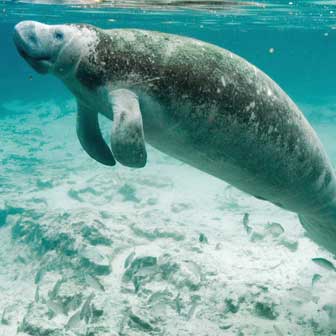
Manatee Facts
- Manatees are mammals.
- Manatees are also known as "Sea Cows".
- Manatees along with Dugongs and the now extinct Steller's Sea Cow are all a type of mammal classified together as sirenians.
- Manatees cannot breathe underwater, but must come up to the surface for air.
- Like whales, a manatee can replenish up to 90 percent of the oxygen in their lungs with one breath. People can only replenish about 10 percent with a single breath.
- Manatee live in the water all the time.
- Manatees seem to prefer water 3 to 6 feet deep (1 to 2 meters). When they travel in the ocean they seem to avoid water more than 20 feet (6 feet) deep.
- Manatees sleep underwater. As they sleep they rise to the surface every 2 to 12 minutes to take a breath will still asleep.
- Manatees are found in the United States in Florida and Southern Georgia. They are also found in the Caribbean and the Amazon River Basin.
West Indian Manatee Facts
- West Indian manatees are subdivided into two groups including the Florida manatee and the Antillean manatee.
- The West Indian manatee has the highest risk of extinction.
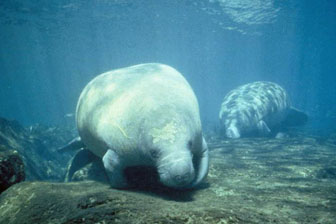
West Imdian Manatees feeding on bottom vegetation.
Florida Manatee Facts
- Florida Manatees are a subspecies of the West Indian manatee.
- Less than 3000 Florida Manatees are estimated to be alive outside of zoos and aquariums.
- The average Florida manatee grows to a size of 10 feet (3 meters) and weight of 1200 pounds (500 kg). Female Florida manatees are known to grow larger than males.
- Florida manatees have a large body with a smaller head and flat tail. They have a pair of flippers to help them swim and hold their position in the water. Their flippers have 3 to 4 fingernails.
- Florida manatees live year-round in warm waters in Florida and Southern Georgia. During the summer, Florida manatee are known to travel to Louisiana to the West, the Bahama Islands to the East and as far north as Rhode Island.
- Florida manatees do not survive very long in cold water. Sudden cold weather can be harmful to manatees.
- Florida manatees live in bays, rivers, estuaries, man-made channels, inter-coastal waters and shallow coastal ocean waters in the Atlantic Ocean and the Gulf of Mexico.
- Since manatees spend most of their time in shallow water near the surface, they often encounter people on boats. Many manatees have been injured by boat propellers. People in the United State have made a large effort in recent years to slow boat traffic or keep boats away from areas where manatees live.
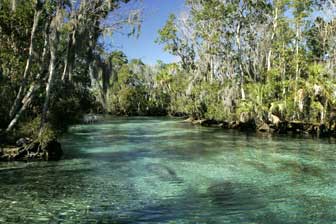
Manatees live in warm shallow inland water and in coastal areas
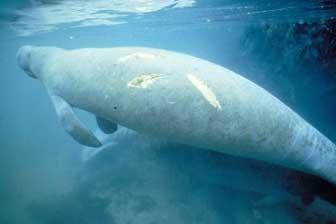
Since manatees live in shallow water they are often injured or killed by boat propellers like this Florida Manatee.
West African Manatee Facts
- West African manatees live in dozens of countries on the west side of Africa.
- West African manatees can grow over 14 feet (4.5 meters) in length and weigh almost 800 pounds (over 350 kg).
- West African manatees live in shallow coastal waters, rivers, bays, lagoons and fresh water lakes.
- West African manatees live in warm water, preferring water temperature over 64 degrees F (18 degrees C).
- Seeing a wild West African manatee is somewhat rare. Not many have been seen by people except people who hunt West African manatees.
- West African manatees feed mostly on plants. The plants they seem to prefer are floating aquatic plants, but they will feed on bottom vegetation as well.
Amazonian Manatee Facts
- Amazonian manatees are the smallest type of manatee. They grow to a full size of 9.2 feet (2.8 meters) with a weight just over 1000 pounds (480 kg).
- Scientists can tell Amazonian manatees from West Indian and West African manatees because they have no toenails on their pectoral flippers.
- Amazonian manatees are also known for their distinctive white or pink markings on their belly.
- Amazonian manatees have small eyes, but are thought to have very good hearing which would be more helpful in the extremely muddy water of the Amazon River.
- Amazonian manatees mostly live in the Amazon River and its tributaries. Their range includes the countries of Brazil, Peru, Columbia, Guyana and Ecuador.
- The Amazonian manatee is the only manatee that lives only in fresh water.
- During the rainy season along the Amazon River, Amazonian manatees feed on the vegetation that flows into the river basin from flooded areas. When water levels start to lower the manatees move into the main river channel or to permanent lakes until the next rainy season (December to June).
- Amazonian manatees are very hard to find in the wild. The water they live in is very muddy. Also, Amazonian manatees only lift their nose slightly above water to breath.
- It is thought that there are over 10,000 Amazonian manatees in the wild.
Dugong Facts
- Scientists estimate that there are over 100,000 dugongs living in the wild.
- Dugongs are found in coastal areas in the Indian Ocean. They are also found in the coastal waters of Northern Australia.
- Dugongs are typically found in water 16 feet (5 meters) or less in depth. Dugongs have been found in water over 120 feet (35 meters) deep.
- A dugong's main food is seagrass, so they typically stay in areas somewhat near seagrass for easy access to food.
- The average size dugong is 9 feet (3 meters) long and weighs between 550 and 650 pounds (250-300 kg).
- Like all other mammals, dugongs have hair on their body. In this case, a dugong has fine, short hair that is barely noticeable.
- Dugongs must breath but swimming up to the surface of the water. Their nostrils are located on the tip of their head so they only need to raise a small part of their head above water to take a breath.
- A dugong is a mammal that is similar to a manatee, but has some very important differences.
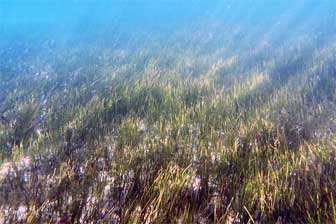
The dugong's favorite food is seagrass
Difference Between Manatees and Dugongs
- Dugongs are in the same animal family as manatees. Manatees, dugongs and the extinct Steller's Sea Cow are all animals known as sirenians. They are very similar, but they have four main differences.
- Manatee and dugong teeth are different. A manatee has molars that contantly grow and move forward. Eating the vegetation wears their teeth out, but new teeth constantly push forward. Dugongs can replace the last two teeth, but they do not constantly move forward.
- A dugong has 7 vertebrae. A manatee has 6 vertebrae.
- Once a dugong is fully grown, it develops two tusks. Male dugongs have tusks that are easy to see. Manatees do not have tusks.
- Manatees have a tail that has a shape like a wide flat paddle. Dugongs have a fluked tail, which is like a whale or dolphin.
